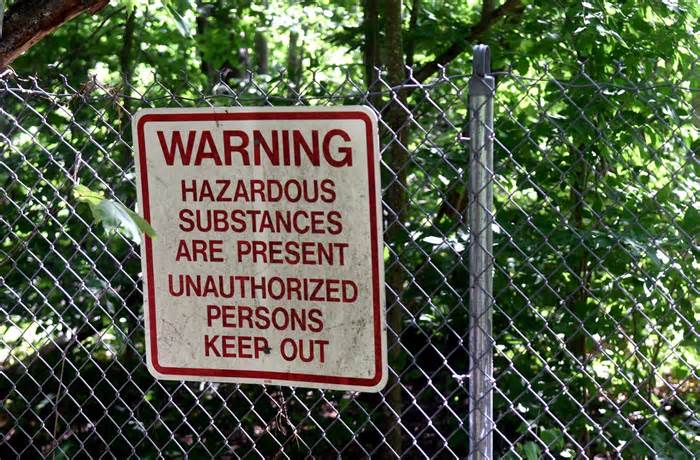DOVER – The city is working to upgrade a treatment system to prevent dangerous chemicals in groundwater from migrating any closer to the Bellamy Reservoir, which is the city of Portsmouth’s primary drinking water supply.
Dover City Manager Michael Joyal and an environmental consultant for the city said the “southern plume” of chemicals has already moved off the Tolend Road Landfill, a Superfund cleanup site adjacent the reservoir.
The plume contains both PFAS chemicals – more commonly known as forever chemicals – and 1,4-dioxane, according to Dean Peschel, an environmental consultant for the city. PFAS and 1,4-dioxane are suspected carcinogens, the Environmental Protection Agency has said.
Peschel stated “we don’t really want any of this to get to the reservoir” about the PFAS and 1,4-dioxane.
The enhancement of the existing seasonal Southern Pumping Station is being designed now and could be installed in the fall, Peschel said. Cost to upgrade the system is estimated at $200,000 to $700,000, he said.
There is a separate pump and treat system at the landfill which has been working to remove volatile organic compounds (VOCs) and arsenic from the groundwater there.
The enhancement is aimed at heading “off any of the contamination headed toward the Bellamy,” he said.
“You can see it’s pretty close to the Bellamy Reservoir here,” Peschel told the City Council this week as he pointed to a map showing where 1,4-dioxane was detected.
Because the Tolend Road Landfill, which was also known as the Dover Municipal Landfill, is a Superfund site, the EPA must approve the design of the system, Peschel said.
“But regardless of that we still need to proceed with putting in some sort of system to intercept, pull back and draw the contaminants,” he said.
Such a system, he said, is aimed at keeping them “from migrating farther off the landfill site.”
The former landfill sits on a 50-acre site off Tolend Road, and the southern boundary is about 2,000 feet away from the Bellamy Reservoir, according to the EPA’s website.
“Owned and operated by the city of Dover from 1960 until its closure in 1980, the landfill accepted domestic and industrial waste,” the EPA states on its website. “Buried materials include leather-tanning wastes, organic solvents, municipal trash and sludge from the Dover wastewater plant.”
Brian Goetz, deputy director of public works for the city of Portsmouth, said Thursday he’s aware of the issue.
“We have been tracking that for years and have been involved and meeting with Dover about it,” said Goetz, who is in charge of Portsmouth’s water system.
He noted that despite concerns about PFAS and 1,4-dioxane, “there’s no detection of anything that has gotten into the reservoir.”
“Granted, the landfall is adjacent to the reservoir … and the migration is a concern of ours,” he said.
He’s pleased that Dover is working to design a system to address the issue “prior to anything getting to the reservoir.”
It’s unclear how close the plume is to the reservoir and what levels of PFAS and 1,4-dioxane were found there.
The EPA did not immediately respond Thursday to request for that information.
The city of Portsmouth closed its Haven well at the former Pease Air Force Base in 2014 after multiple PFAS chemicals were detected in the water. Thousands of people working at what is now the Pease International Tradeport, along with children and infants who attended two day care facilities there, were exposed to the chemicals. The water was contaminated by firefighting foam used at the base.
PFAS are man-made chemicals that have been used in products worldwide since the 1950s, including firefighting foam, non-stick cookware and water-repellent fabrics. They also have a range of applications in the aerospace, aviation, automotive and electronics industries, among others.
In addition to being a suspected carcinogen, the Agency For Toxic Substances and Disease Registry states PFAS exposure can harm childhood development, increase cholesterol levels, hurt the immune system and interfere with the human body’s hormones.
The EPA states “1,4-dioxane is a likely human carcinogen and has been found in groundwater at sites throughout the United States. … The physical and chemical properties and behavior of 1,4-dioxane create challenges for its characterization and treatment. It is highly mobile and does not readily biodegrade in the environment.”
In terms of the Bellamy Reservoir, Goetz stressed “they are both things we’ve sampled for at our intake (to the reservoir) and we have just barely detectable levels for PFAS and non-detect levels for 1,4-dioxane.”
Joyal, Dover’s city manager, on Thursday said the chemicals in the plume “are not currently threatening the reservoir.”
“I think not just Portsmouth but we too are concerned and we want to make sure that whatever contaminants are emanating from the landfill are held in check,” Joyal said. “Right now, there’s no immediate threat to the Bellamy Reservoir.”
He added the city “is certainly being proactive” to address the issue. “We want to make sure any contaminants are being blocked from ever reaching the Bellamy Reservoir.”
The city of Dover is responsible for paying for slightly more than 50% of the cost of the enhanced system, Joyal said. The rest will be paid for by the other “potentially responsible parties,” the name for companies that used the landfill when it was operating.
The city of Dover alone has paid “well in excess of $20 million” to clean up and monitor the landfill since its closure, Joyal said.
During Wednesday’s council workshop meeting, Joyal described the landfill as “another environmental obligation here in this community, a longstanding one and one that will continue for quite some time.”
Looking back on how the landfill operated, Joyal said, “This is an example of what we wish we knew back then.”
“If we saw it operate that way today we’d be horrified,” he added.
Gannett | USA TODAY NETWORK
Choose the plan that’s right for you. Digital access or digital and print delivery.

